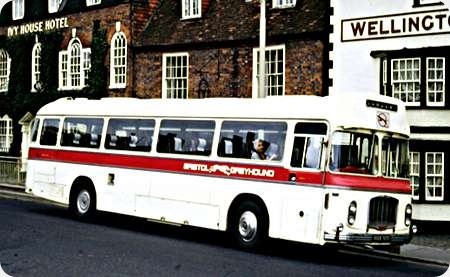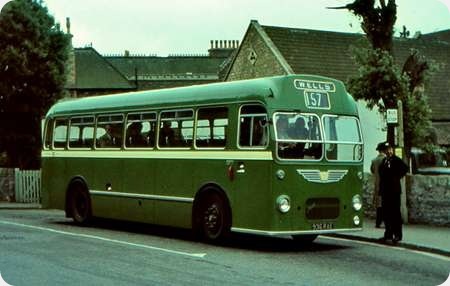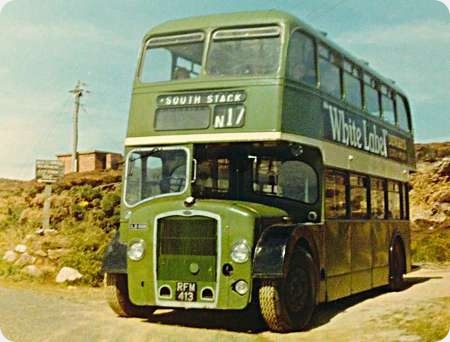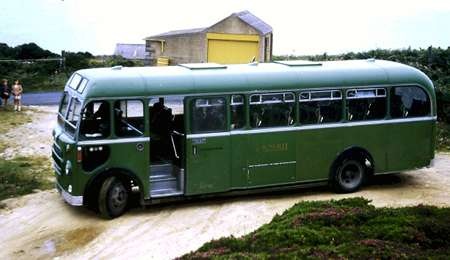
Greyhound Motors Ltd
1968
Bristol RELH6L
ECW C45F
On 10th February 1925 The Greyhound Motors Ltd introduced an express stage service between Bristol and London. It was apparently an immediate success despite the GWR railway between the two cities. In 1928 the company was acquired by the Bristol Tramways and Carriage Company later renamed the Bristol Omnibus Company but the Greyhound name remained in use until 1973 when it was replaced by the NBC corporate National image. A 1970 timetable recorded a total journey time of 4 and 3/4 hours for most services via Bath Chippenham Newbury and Reading which included a 15 minute comfort stop in Marlborough. The photo taken in 1972 in Marlborough shows one of the 1968 Bristol RELH6L coaches which were originally delivered in the red and cream livery and briefly repainted into white and magenta with a revised Greyhound motif.
Photograph and Copy contributed by Keith Newton
10/09/15 – 07:24
Nice view, Keith. Thank you for posting. Did any of the ‘captive’ Bristol/ECW fleets have any coaches with toilets, as Standerwick and Midland Red did?
The CAPTCHA code for this comment may well set hearts afluttering in Southdown territory: 5UUF.
Pete Davies
11/09/15 – 05:37
The T-style destination on Bristol Omnibus Company’s RE coaches gave a very distinctive touch to a classic body design. The greyhound motif on the number box on this example is a nice touch.
Don McKeown
11/09/15 – 05:39
Marlborough, was also an interchange point, between Associated Motorways Services and Royal Blue with Greyhound, they had a large shop with a cafe, waiting room, and booking office in the main square. It did not appear in the time table as such, but if you phoned ahead they would hold connecting service until you arrived, passengers would be informed this would be an extra [with 10 bob being spilt between drivers, by regular passengers who knew this to be so] cheaper than a taxi. Toilets on Greyhound coaches, no, only those stationed at St Marks, which sums them up, end of life, one season at St Marks then the scrapper, if they where ok they would have been converted into DPs for Bristol and Bath.
Mike
12/09/15 – 14:34
Thank you, Mike, for your comment about toilets on these vehicles. Any thoughts, please, from anyone about the facility on coaches in other “Tilling” fleets?
Pete Davies
13/09/15 – 05:51
Pete, I’m going to stick my neck out and say “no” . . . in so far as “proper” Tilling fleets were concerned. But, THC-wise, I’m sure SOL had some Bristol RELL/Alexander Y-types (which pre-dated the M-types) fitted with toilets for its Edinburgh-London overnight services. Hang-on! didn’t Western SMT fit toilets to some of its coaches (Alexander/Guy LUFs?) to counter Northern Roadways toilet-equipped coaches on the Glasgow-London route? Where’s my Northern Roadways book . .
Philip Rushworth
13/09/15 – 05:52
Bristol Greyhound RELH6/ECW coaches to the best of my knowledge never had the luxury of toilet facilities, relying on numerous breaks at the many stop-overs on the way. On checking most other Tilling fleets with long distance coaches, even United Autos did not have them on their long distance Newcastle-London service. In fact the only ECW bodied vehicles I know of that did would be the 30 Bristol VRL/LH6L megadeckers with Standerwick used on the non-stop routes from the North West to London. The Bristol RELH6Gs used on the Edinburgh and Glasgow routes all had toilet facilities but they had Alexander M series bodies.
Ron Mesure
14/09/15 – 06:15
Toilets. Northern Roadways Burlingham coaches had toilets and refreshments on board but the 50% relief coaches did not, the hostess with big teapots would transfer over to dispense drinks and snacks often done in laybys on the A1. Passengers would have to wait until coaches pulled into top up fuel tanks for toilets, other operators had toilets but not refreshments.
Mike
15/09/15 – 06:39
Thanks for your thoughts about toilets on the “Tilling Fleets” vehicles. Much as I thought.
Pete Davies
15/09/15 – 12:29
Couple small points, pre war SMT and Western operating Anglo Scottish services had fitted toilet compartments to their Gilford AEC and Leyland Coaches; as Did Scout and Standerwick on London- Blackpool.
Northern Roadways’ plans to introduce toilet accomodation on its Seagulls led to SMT and Western reintroducing the feature, initially on Alexander bodied Regal IVs, SMT then used small engined Reliances, the later ones 36ft and Western sucessively Guy Arab UF (end an eight-cylinder Albion Prototype) Guy Arab LUF, Leyland Leopard L1 and PSU3 Leopard. Then came the RELHs (not RELLs) an the the initial M Types on REMH.
No Tilling fleet had a toilet fitted coach from 1945-69 but its interesting to note that United’s RELHs only sat 43, compared to the standard 47 and 51 in the Midland General semi-coaches. United were of course the only other customer than Western and Eastern for the REMH6G, taking batches between 1971 and 1973 with C49F Plaxton bodies. In NBC days Tilling had some RELH Plaxtons with toilets.
Stephen Allcroft
01/11/19 – 13:46
Much has been said (including by me!) of the sturdiness of Bristol/ECW products, but I recall a story I heard about the earliest batch of RELH6G’s delivered to United Counties (250 et seq.). It is alleged that one of them was reversing out of the strange outdoor layover bay next to the entrance to Northampton’s Derngate bus station when a mini ran into the rear overhang doing considerable structural damage! This would have been about 1970 and I recall seeing the early examples running around after that with a heavily plated repair along the waistrail behind the rear wheel. Can anyone shed any light on this? I have Duncan Roberts’ ‘Bristol RE 40 Years of Service’ but I don’t think this episode gets a mention in his excellent tome.
Phil Roderick




